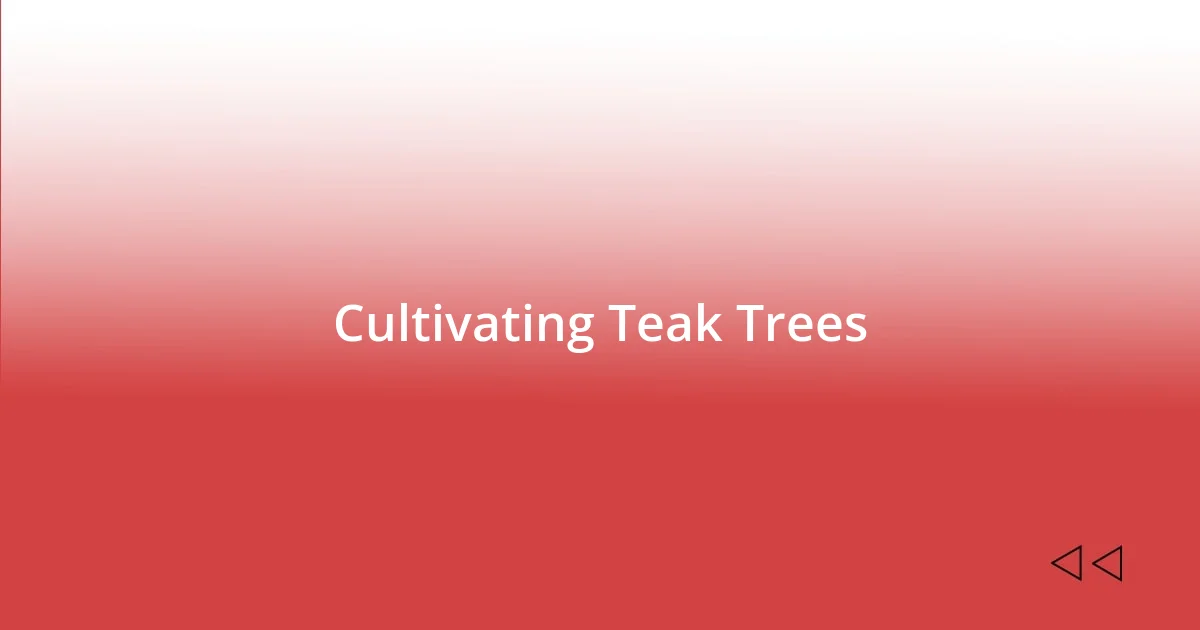Key takeaways:
- Teak trees (Tectona grandis) are long-lived, durable, and crucial for ecosystems, necessitating responsible forestry practices for their preservation.
- Teak wood is valued for its natural resistance to decay, low maintenance, and thermal properties, making it ideal for outdoor furniture.
- Successful cultivation and harvesting of teak require attention to soil quality, sunlight, and pest management, emphasizing patience and care in the process.

Understanding Teak Trees
Teak trees, scientifically known as Tectona grandis, are renowned for their durability and resistance to water and insects. I remember the first time I encountered a teak tree; its magnificent height and broad leaves left me in awe. Have you ever stood next to a tree that made you feel so small? That’s the kind of presence teak trees have.
These trees can live for over a century, providing not just timber but also habitat for countless organisms. I often think about the life stories that unfold around such trees—the birds nesting in their branches, the insects buzzing around their bark. Who wouldn’t be fascinated by how an ecosystem thrives around a single tree?
Growing up in a region where teak is more than just wood, I learned that sustainable harvesting is crucial for preserving these giants. It’s shocking to realize that many people still don’t understand the importance of responsible forestry practices. What’s the real cost of ignoring this? The future of these majestic trees relies on our commitment to their preservation, and it’s a responsibility I take seriously.

Benefits of Teak Wood
Teak wood is highly valued not only for its aesthetic appeal but also for its remarkable qualities. One of the most significant benefits is its natural resistance to rot and termites. I’ve noticed that furniture made from teak stands the test of time, even when exposed to the elements. Have you ever invested in a piece of furniture only to see it fall apart after a season? With teak, that concern fades away, as it ages beautifully and retains its strength.
Another noteworthy advantage is its low maintenance requirement. Unlike other woods that may require frequent finishes or treatments, teak can be left untreated, and still maintain its integrity. I think back to the days when my family chose a teak dining table; it hardly needed any upkeep, allowing us to focus more on the memories made around it rather than constant repairs. Isn’t it satisfying to own something that effortlessly brings beauty and durability into your life?
Furthermore, teak wood’s thermal properties are impressive. It stays cool even in warm conditions, making it an ideal choice for outdoor spaces. I remember spending sunny afternoons on my teak patio furniture, appreciating how it offered comfort even on the hottest days. It’s like having a slice of nature that brings both style and practicality to our lives.
| Benefit | Description |
|---|---|
| Durability | Resistant to decay and insects, ensuring longevity. |
| Low Maintenance | Requires little upkeep while retaining its appearance. |
| Thermal Properties | Stays cool in warm conditions, enhancing outdoor comfort. |

Cultivating Teak Trees
Cultivating Teak Trees
Cultivating teak trees requires patience and dedication. I’ve often thought about how planting a teak sapling is like planting a piece of history; you nurture it, and in return, it offers benefits for generations. It’s fascinating to witness the transformation from a tiny seedling to a towering tree. When I planted my first teak at home, it felt like starting a journey that would last beyond my own lifetime.
To successfully cultivate teak trees, several essential factors must be considered:
- Soil Quality: Teak thrives in well-drained, sandy loam with a pH of 6.0 to 7.5. I recall the moment I tested my soil; it was a simple yet rewarding experience that made me feel more connected to the land.
- Sunlight: These trees need full sun for optimal growth. I’ve noticed how the light filtering through the leaves creates a dance of shadows – a beautiful reminder of nature’s artistry.
- Watering: Young teak saplings require regular watering, especially in dry periods. I remember the joy of witnessing a new leaf sprouting after diligently tending to my saplings.
- Spacing: Proper spacing is crucial for airflow and growth, ideally 3 to 4 meters apart. Each sapling feels like a friend, growing together in harmony, almost as if they are sharing secrets with each other.
These elements weave together to create the ideal environment for teak trees to flourish, bringing a sense of accomplishment and joy to those who cultivate them.

Caring for Teak Trees
Caring for teak trees is an enriching experience that demands attention and care. I vividly recall learning about pruning techniques after I noticed my young trees growing a bit wild. Cutting back the extraneous branches not only improved their shape but also allowed for better air circulation and sunlight penetration. Does it feel strange to shape a living thing? It did at first, but witnessing the trees thrive after a good trim made it immensely gratifying.
Regularly checking for pests is another crucial aspect of nurturing teak trees. While they are naturally resistant to many insects, I once discovered a small wave of caterpillars feasting on the leaves of my favorite sapling. I took a deep breath, reminded myself that nature has its challenges, and used organic methods to protect it. The relief of seeing the leaves bounce back was a lesson in resilience, both for the tree and myself. Have you ever felt that surge of panic only to find a way to manage it?
Lastly, fertilization plays a vital role in the overall health of teak trees. I remember my first attempt at applying organic compost; it felt as if I was feeding my trees a nutritious meal. The lush, green growth that followed was like a personal win. Teak thrives on nutrients, especially during its early years, and feeling that connection as you witness their growth is simply unparalleled. It’s a pleasure to contribute to the nurturing of such magnificent trees, knowing they will stand tall long after I’m gone.

Common Pests and Diseases
One of the most common pests that can plague teak trees is the teak defoliator, also known as the Hyblaea puera. I remember the first time I encountered these pests; it felt as if my trees were being stripped of their vitality right in front of my eyes. I quickly learned that these caterpillars could cause significant leaf loss, which hindered the tree’s growth. It’s truly alarming to see nature in a tug-of-war, and finding effective control methods became a personal quest for me.
Fungal diseases, like teak leaf blight, can also affect these magnificent trees. There was a moment when I noticed black spots dotting the leaves, which made my heart sink. Understanding the importance of addressing such issues, I turned to natural fungicides and careful pruning. It struck me how vulnerability and strength coexist in the life of a tree. Have you ever felt compelled to fight for something precious? That’s how I felt during those challenging weeks as I worked to restore my trees to health.
Lastly, as soon as the rainy season hits, I always keep an eye out for root rot due to waterlogging. I vividly recall a time when I did everything right with my watering schedule, yet persistent rains caused my sapling to wilt. The panic was real; it’s like watching your dreams fade. Implementing proper drainage solutions made all the difference afterward. Each incident with pests and diseases has taught me patience and resilience. I’ve come to appreciate how these challenges forge a deeper bond between me and my teak trees, transforming struggle into a powerful narrative of growth.

Harvesting Teak Wood
Harvesting teak wood is a meticulous process that requires timing and intuition. I remember the day I was finally ready to cut my first teak tree. Standing there, the scent of the fresh wood filled the air, and I couldn’t help but marvel at the beautiful grain patterns revealed as the blade sliced through; it felt like unearthing a treasure hidden inside.
The ideal time for harvesting teak varies, but I’ve found that waiting until the trees are around 20 years old improves quality significantly. When I made my first harvest, the grain was dense and rich in color, far superior to that of younger wood. Do you ever think about the stories that a piece of wood can tell, the years it has taken to grow? Each ring seems to whisper tales of the environment it thrived in, making the woodworking process all the more meaningful.
An important factor I learned was to ensure that the tree is healthy before cutting. I once made the mistake of choosing a tree that looked good above ground but was struggling with root issues. What a disappointment it was! Many craftsman prefer to select only the best specimens to ensure the wood’s integrity. The experience taught me that patience in the harvesting process translates into better results, allowing the harvested wood to embody the essence of the tree’s life.















